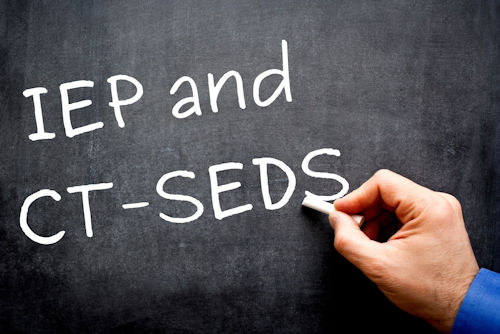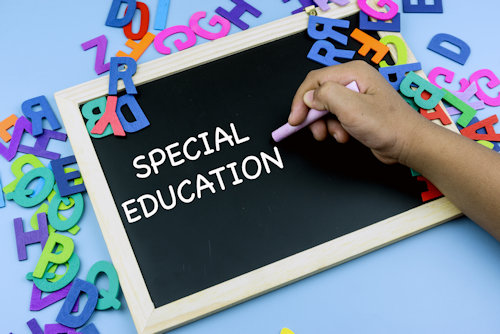Assistive Technology
Assistive Technology (AT)
is any item, piece of equipment, or product system that is used to help increase,
maintain, or improve functional capabilities of individuals with disabilities. There
are many types of AT, ranging from low-tech to high-tech options. AT can be a simple
item such as an adaptive spoon or pencil, or very high-tech, such as an electric
wheelchair or an
augmentative and alternative communication (AAC)
speech-generating device.
Surgically implanted devices are not considered AT under the Individuals with Disabilities Education Act (IDEA). Assistive technology is one of five special factors that Planning and Placement Teams (PPTs) must consider for students as they develop the Individualized Education Program (IEP). While some of the special factors are for specific students (such as deaf and hard of hearing), the need for AT should be considered for all students with disabilities, regardless of their disability.
Connecticut (CT) documents AT in a student’s IEP with the goal that it supports, as well as in the supplementary aids and services section. The Connecticut Assistive Technology Guidelines were developed by the CT State Department of Education for Planning and Placement Teams. This comprehensive guide covers important topics such as consideration of AT, assessment for AT, and implementation of AT as part of the IEP or Individual Family Service Plan (IFSP).
As part of a free, appropriate, public education (FAPE) assistive technology that is part of an IEP should be of no cost to families. IDEA does allow for certain services to be paid for through Medicaid, so a district can request parental consent to bill Medicaid. Parents can revoke their consent at any time, and districts are still required to provide the services if they cannot bill Medicaid. There are times when a parent might choose to purchase AT through their own medical insurance for various reasons, but there is no requirement to do so.
Assistive Technology in the IEP may require related services such as parent training and speech and language services for a student who has an AAC device. This particular AT will be linked to the student’s communication goals, and the Speech and Language Pathologist (SLP) will support the student’s communication, including with the AAC device. Parents can request training as a related service in the IEP to help them learn how to use and model communication on the device with the student outside of the school day. AT such as AAC may also require indirect services, such as training for the student’s other school team members to use and model communication on their specific device. Consultation time with an outside professional would also be considered an indirect service. These are considered indirect services because while it is needed to implement the IEP, the service will be provided to the school team rather than directly to the student. In Connecticut’s IEP form, Indirect Services will be listed after Related Services.
» Assistive Technology PDF
Surgically implanted devices are not considered AT under the Individuals with Disabilities Education Act (IDEA). Assistive technology is one of five special factors that Planning and Placement Teams (PPTs) must consider for students as they develop the Individualized Education Program (IEP). While some of the special factors are for specific students (such as deaf and hard of hearing), the need for AT should be considered for all students with disabilities, regardless of their disability.
Connecticut (CT) documents AT in a student’s IEP with the goal that it supports, as well as in the supplementary aids and services section. The Connecticut Assistive Technology Guidelines were developed by the CT State Department of Education for Planning and Placement Teams. This comprehensive guide covers important topics such as consideration of AT, assessment for AT, and implementation of AT as part of the IEP or Individual Family Service Plan (IFSP).
As part of a free, appropriate, public education (FAPE) assistive technology that is part of an IEP should be of no cost to families. IDEA does allow for certain services to be paid for through Medicaid, so a district can request parental consent to bill Medicaid. Parents can revoke their consent at any time, and districts are still required to provide the services if they cannot bill Medicaid. There are times when a parent might choose to purchase AT through their own medical insurance for various reasons, but there is no requirement to do so.
Assistive Technology in the IEP may require related services such as parent training and speech and language services for a student who has an AAC device. This particular AT will be linked to the student’s communication goals, and the Speech and Language Pathologist (SLP) will support the student’s communication, including with the AAC device. Parents can request training as a related service in the IEP to help them learn how to use and model communication on the device with the student outside of the school day. AT such as AAC may also require indirect services, such as training for the student’s other school team members to use and model communication on their specific device. Consultation time with an outside professional would also be considered an indirect service. These are considered indirect services because while it is needed to implement the IEP, the service will be provided to the school team rather than directly to the student. In Connecticut’s IEP form, Indirect Services will be listed after Related Services.
» Assistive Technology PDF












